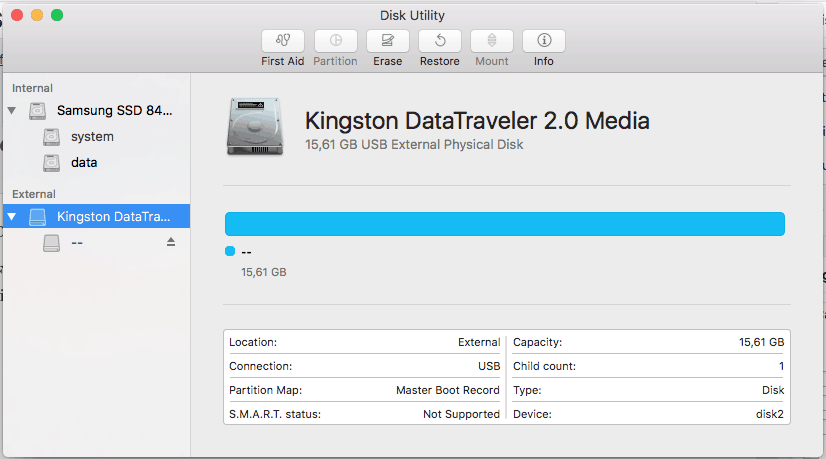

- #What format does a usb need for mac and pc how to#
- #What format does a usb need for mac and pc install#
- #What format does a usb need for mac and pc full#
- #What format does a usb need for mac and pc windows 10#
- #What format does a usb need for mac and pc software#
If you only want to work or collaborate on a few files, why not ditch the drives altogether and place your files in the Cloud?
#What format does a usb need for mac and pc windows 10#
When using BootCamp remember that any files you save to the Windows 10 section of the hard disk itself can’t be accessed when you reboot into macOS and vice versa. If you enjoy using the iWorks app however (Pages, Keynotes & Numbers), you can work with the online versions of these tools on a PC by accessing iCloud via your browser. You’ll also naturally will have to work with files using Microsoft apps instead of those designed for Mac like iMovie.
#What format does a usb need for mac and pc how to#
See our guide on setting up BootCamp for more details on how to get started.Īlthough BootCamp is easy to set up and use, you must purchase a Windows 10 license to keep using the OS after 90 days. To get started, all you need is an internet connection, a valid Windows 10 DVD and a USB stick of at least 8GB.

This includes working with NTFS-formatted drives. Once set up, Windows 10 will function on your Mac in just the same way as it would on a regular PC. This allows you to boot both operating systems on your Mac. During the setup process, users shrink the size of their existing macOS installation to make room for Windows. The most recent version of macOS ( Mojave) supports Windows 10. You should now be able to edit existing files and copy new ones here.īootcamp is macOS’ own built-in utility for installing Microsoft Windows on your Mac. Open Finder, then click Go’> Go to Folder, then type ‘/Volumes/NAME’ where ‘NAME’ is the name of your NTFS drive.Ĭlick ‘Go’ to access your Windows disk. Next, connect your Windows drive to the Mac. Press Ctrl+O to save the list, and then press Ctrl+X to exit NANO. USB1 (if you’re unsure what this is, simply open Disk Utility): LABEL=NAME none ntfs rw,auto,nobrowse Use the arrow keys on your keyboard to scroll to the very end and add the following line, replacing ‘NAME’ with the actual name of your NTFS drive e.g. This will open the list of drives recognised by macOS. Connect your NTFS drive, then enter the command: sudo nano /etc/fstab To get started, click the Spotlight icon at the top right of your screen and enter ‘Terminal’. As this feature is still in the testing phase however, your files could become corrupted at anytime, so proceed with caution.
#What format does a usb need for mac and pc software#
The main benefit of using Terminal in this way is that it’s quick to do and no third-party software is required.
#What format does a usb need for mac and pc full#
This is an experimental feature and could lead to data loss, so make sure to do a full backup of both your Mac and any data on the drive before continuing. Though, if your Mac is based on Apple Silicon, you may find incompatibilities.If reformatting your NTFS drive for Mac is not an option, you can enable write support for specific Windows disks using macOS Terminal.
#What format does a usb need for mac and pc install#
In theory, there’s no reason why you couldn’t boot an older version of macOS, and Apple does offer ways to install older versions on a USB. Can I boot older versions of macOS from a USB drive? Our testing gave us no issues when using a USB 2.0 to USB-C connector, so you’re able to press your older USB drives into service. Am I able to use a USB connection other than USB-C? We recommend 16GB to give yourself enough “wiggle room” when it comes to the installation process. As such, you’ll need a large enough USB drive to store Big Sur. In our experience, you will not be able to do this. Can I split an installation across multiple USB drives? Disk operations on the boot drive can be performed safely from a USB stick as well. You can now run the operating system as normal and use this USB drive to boot up your Mac. If you’re using an Apple Silicon machine, you’ll need to insert the USB drive, shut the Mac down, then reboot and hold the Power key until you come to the Startup Manager.įor Intel Macs, restart and hold the Option key to enter into the boot selection dialog.įor both types of machines, use your keyboard’s arrow keys to select the USB drive from the list of bootable devices, click to confirm, and your USB drive will begin to boot. You could also use the Startup Manager to select your boot drive when you start macOS. Your Mac will reboot from the USB instead of your default startup disk.


 0 kommentar(er)
0 kommentar(er)
